Uniform Circular Motion - Definition, Examples, Diagram, Characteristic, Examples, FAQs
An object is said to be in uniform circular motion when it moves around a circular path at a constant speed (but the velocity keeps changing). This means it covers equal distances in equal times, but its direction keeps changing. This happens because a centripetal force continuously pulls the object toward the center of the circle. In this topic,students will learn how force, velocity and acceleration work together to keep an object moving in a circular path. Uniform circular motion is an important topic of Class 11 Physics and is often asked in board exams and competitive exams like JEE Main, NEET, BITSAT, WBJEE and others. Many questions have been asked from this concept in previous years.
This Story also Contains
- What Is Uniform Circular Motion?
- Uniform Circular Motion Formula
- Terms Related to Uniform Circular Motion
- Relation Between Angular Acceleration and Tangential Acceleration
- Uniform Circular Motion Examples
- Uniform Circular Motion Questions and Answers
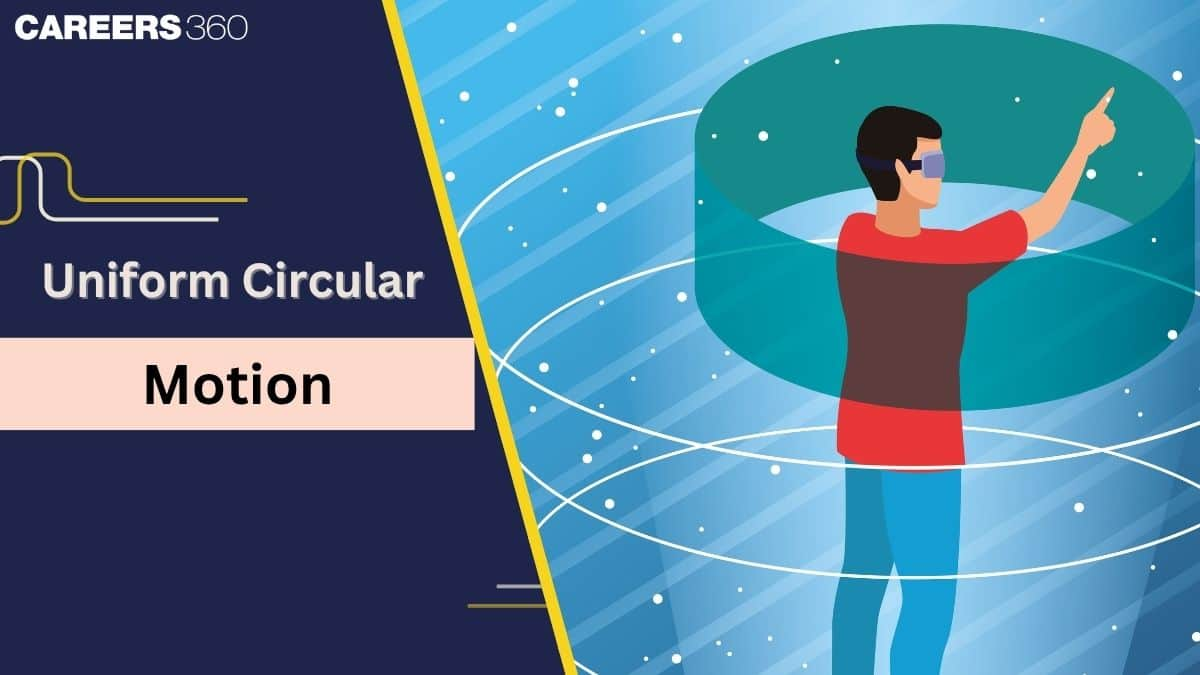
What Is Uniform Circular Motion?
Circular motion is the motion of a body travelling in a path around a fixed point in the shape of a circle. Uniform circular motion implies that if the body travels equal distances along the circumference of the circle in equal intervals of time, then the motion is said to be uniform circular motion. Naturally, this means that it is a type of circular motion in which the speed is maintained while the direction of the velocity is altered.
Uniform circular motion examples:
(i) Motion of the moon around the Earth
(ii) Motion of a satellite around its planet
Note: Circular motion is also known as accelerated motion
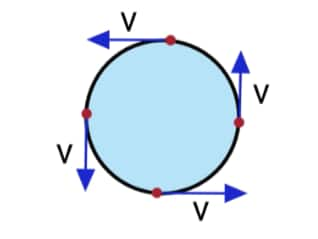
Uniform Circular Motion Formula
Uniform circular motion Formula Class 9 or other classes are given here.
In uniform circular motion, a particle moves with constant speed.
- Angular displacement $\Delta \theta=\frac{\operatorname{Arc}\left(P P^{\prime}\right)}{r}$
- Angular velocity $\omega=\frac{\Delta \theta}{\Delta t}=\frac{2 \pi}{T}=2 \pi v$
- Linear speed $v=r_\omega$
-
Centripetal acceleration is due to a change in direction of velocity and is always directed towards the centre.
$
a={v^2/r}=r \omega^2=4 \pi^2 v^2 r=v \omega
$
Terms Related to Uniform Circular Motion
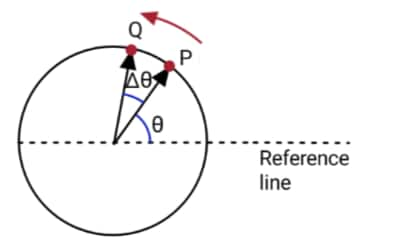
The term related to circular motion is given below:
Radius vector
The vector joining the centre of the circular path to the position on the circular path is called the radius vector.
Angular position
The angle made by the radius vector with a reference line (arbitrarily chosen diameter) is called angular position. The direction of angular position can be clockwise or anticlockwise depending upon the choice of frame of reference. The angular position of the particle at position "P" is denoted by the y $\text { angle } \theta$ in the diagram above.
Angular displacement
The change in angular position is called angular displacement. It is the angle through which the radius vector rotates during the given circular motion.
The angular displacement between positions 'P' and 'Q' is denoted $\text { by } \Delta \theta$ in the diagram above with the S.I unit of angular position and angular displacement is Radian.
Angular velocity
Denoted by $\omega$ (omega)
$\omega$-Rate of change of angular displacement.
Average angular velocity-
$
\omega_{\text {avg }}=\frac{\Delta \theta}{\Delta t}
$
Instantaneous angular velocity
$
\omega=\frac{d \theta}{d t}
$
S.I. units- Radian per second (rad per sec )
$\omega$ is a vector quantity
The direction of $\omega$ is given by the Right-hand rule.
According to the right-hand rule, if you hold the axis with your right hand and rotate the fingers in the direction of motion of the rotating body, then the thumb will point in the direction of the angular velocity.
Angular Acceleration
The rate of change of angular velocity with time is said to be Angular Acceleration.
$
\alpha=\frac{\Delta \omega}{\Delta t}
$
- SI units- $\operatorname{rad} .(\mathrm{sec})^{-2}$
- Angular Acceleration is a vector quantity.
The direction of Angular Acceleration
a) If angular velocity is increasing then the direction of Angular Acceleration is in the direction of angular velocity.
b) If angular velocity is decreasing then the direction of Angular Acceleration is in the direction which is opposite to the direction of angular velocity.
Time is taken to complete one rotation
Formula-
$
T=\frac{2 \pi}{\omega}
$
Where $\omega=$ angular velocity
If $\mathrm{N}=\mathrm{no}$. of revolutions and total time then
$
T=\frac{t}{N} \text { or } \quad\left(\omega=\frac{2 \pi N}{t}\right)
$
- S.I unit - seconds (s)
Frequency
The total number of rotations in one second.
Formula-
$
\nu=\frac{1}{T}
$
- S.I. unit $=$ Hertz
We can write the relation between angular frequency and frequency as
$
w=2 \pi \nu
$
Centripetal Acceleration and Tangential acceleration
Centripetal acceleration: When a body is moving in a uniform circular motion, a force is responsible for changing the direction of its velocity. This force acts towards the centre of the circle and is called centripetal forceThe acceleration produced by this force is centripetal acceleration.

Formula-
$
a_c=\frac{V^2}{r}
$
Where $a_c=$ Centripetal acceleration,
$\mathrm{V}=$ linear velocity
$r=$ radius
Tangential acceleration: During circular motion, if the speed is not constant, then along with centripetal acceleration, there is also a tangential acceleration, which is equal to the rate of change of magnitude of linear velocity.
$a_t=\frac{\mathrm{d} v}{\mathrm{~d} t}$
Relation Between Angular Acceleration and Tangential Acceleration
$\overrightarrow{a_t}=\vec{\alpha} \times \vec{r}$
Where:
- $\overrightarrow{a_t}=$ Tangential acceleration (linear acceleration along the tangent to the circular path)
- $\vec{\alpha}=$ Angular acceleration vector (rate of change of angular velocity)
- $\vec{r}^*=$ Position vector (radius vector from axis of rotation to the point of interest)
Total acceleration

The vector sum of Centripetal acceleration and tangential acceleration is called Total acceleration.
Formula-
$a_n=\sqrt{a_c^2+a_t^2}$
The angle between Net acceleration and tangential acceleration $(\theta)$
From the above diagram-
$
\tan \theta=\frac{a_c}{a_t}
$
Uniform Circular Motion Examples
- Revolution of the Earth around the Sun – The Earth moves in a nearly circular path around the Sun with almost constant speed.
- Motion of a ceiling fan blade – Each point on the blade moves in a circle at uniform speed.
- Movement of a stone tied to a string – When you whirl a stone in a horizontal circle at constant speed, it shows uniform circular motion.
- Revolution of a satellite around the Earth – Artificial satellites move in circular orbits with uniform speed.
- Second hand of a clock – It moves around the clock dial in a circle at a constant speed.
Uniform Circular Motion Questions and Answers
Example 1: If a body moving in a circular path maintains a constant speed of 10 ms-1, then which of the following correctly describes the relation between acceleration and radius?
1) 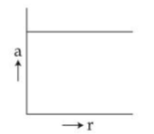
2) 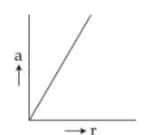
3) 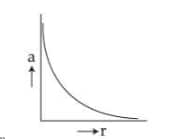
4) 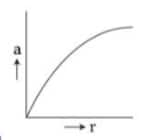
Solution:
$a=\frac{v^2}{r}$
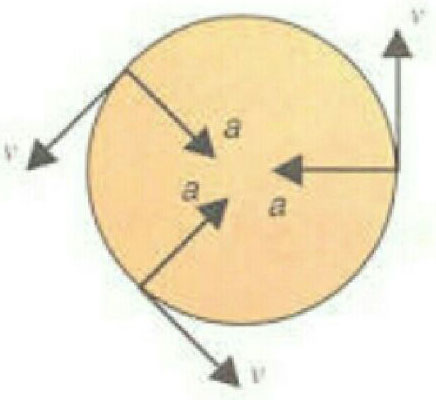
Figure Shows Centripetal acceleration
\begin{aligned}
& a=\frac{v^2}{r} \because|\vec{v}|=\text { constant } \\
& a \propto \frac{1}{r} \text { or } a r=\text { constant }
\end{aligned}
Hence, the graph between a and r will be a hyperbola.
Example 2: A Point P moves in a counter-clockwise direction on a circular path as shown in the figure. The movement of $P$ is such that it sweeps out a length that is in metres and $t$ is in seconds. The radius of the path is $\mathbf{2 0 ~ m}$, The acceleration (in $\mathrm{m} / \mathrm{s}^2$ ) of $P$ When $t=2 s$ is nearly
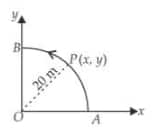
1) 14
2) 13
3) 12
4) 7.2
Solution:
$
\begin{aligned}
& \text { As } S=t^3+3 \\
& V=\frac{d s}{d t}=3 t^2+0 \\
& \Rightarrow v=3 t^2
\end{aligned}
$
tangential acceleration
$
\begin{aligned}
& =a_t=\frac{d v}{d t}=\frac{d\left(3 t^2\right)}{d t} \\
& a_t=6 t
\end{aligned}
$
At $t=2 \mathrm{sec}$
$
\begin{aligned}
& v=3(2)^2=12 \mathrm{~ms}^{-1} \\
& a_t=6 \times 2=12 \mathrm{~ms}^{-2}
\end{aligned}
$
$
\begin{aligned}
& \therefore \text { centripetal acceleration }=\vec{a}_c=\frac{v^2}{r}=\frac{(12)^2}{20}=\frac{144}{20} \\
& a_c=7.2 \mathrm{~ms}^{-2}
\end{aligned}
$
$\therefore$ Net acceleration
$
\begin{aligned}
& a=\sqrt{a_c^2+a_t^2}=\sqrt{7.2^2+12^2} \\
& a_c \simeq 14 \mathrm{~ms}^{-2}
\end{aligned}
$
Example 3: A particle is moving with speed varying as v = 2t, then the angle which the resultant acceleration makes with the radial direction (R=1m) at t = 2 is
$\begin{aligned} & \text { 1) } \tan ^{-1}\left(\frac{1}{2}\right) \\ & \text { 2) } \tan ^{-1}\left(\frac{1}{6}\right) \\ & \text { 3) } \tan ^{-1}\left(\frac{1}{8}\right) \\ & \text { 4) } \tan ^{-1}\left(\frac{1}{4}\right)\end{aligned}$
Solution:
The angle between Total acceleration and centripetal acceleration is given by
$
\tan \phi=\frac{a_t}{a_c}=\frac{r^2 \alpha}{V^2}
$
where
$\alpha=$ angular acceleration
$V=$ velocity
$r=$ radius of circle
So From the below figure

$\begin{aligned}
& \tan \theta=\frac{a_t}{a_r} \\
& a_t=\frac{\mathrm{d} v}{\mathrm{~d} t}=2 \mathrm{~m} / \mathrm{s}^2 \\
& a_r=\frac{v^2}{R} \\
& a_r=\frac{4 t^2}{1}=4 \times 2^2=16 \\
& \therefore \tan \theta=\frac{2}{16}=\frac{1}{8} \\
& \therefore \theta=\tan ^{-1}\left(\frac{1}{8}\right)
\end{aligned}$
Example 4: A particle is moving with a constant speed of 8 m/s in a circular path of radius 1 m. What will be the displacement of the particle in 1 sec?
1) 2 sin 80
2) 2 sin 40
3) 4 sin 80
4) 4 sin 40
Solution:
Displacement in Circular Motion -
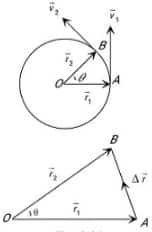
$
\Delta r=2 r \sin \frac{\theta}{2}
$
$\Delta r=$ displacement
$\theta=$ Angle between two vectors
- wherein
$
\text { If }\left|\overrightarrow{r_1}\right|=\left|\overrightarrow{r_2}\right|=r
$
Let the angular displacement of the particle from $\mathrm{A}$ to $\mathrm{B}$ will be
$
2 R \sin \frac{\Theta}{2}
$

Length of circular arc $A B=8 * 1=8 \mathrm{~m}$
$
\begin{aligned}
& \text { Angle } \Theta=\frac{\text { arc length }}{\text { Radius }}=\frac{\Theta}{1}=8 \mathrm{rad} \\
& d=2 R \sin \frac{\Theta}{2}=2 * 1 * \sin \frac{8}{2} \\
& 2 \sin 4^0
\end{aligned}
$
Hence, the correct answer is option (2).
Uniform circular motion involves a particle moving with constant speed along a circular path, whose velocity continuously changes due to the continuous change in direction. A simple example is the merry-go-round in which objects move in circles at an even speed. This concept also applies to natural phenomena like planets orbiting the sun. This understanding of uniform circular motion allows us to comprehend how forces and motion work in circular paths, which is essential for our daily lives and for grasping bigger movements in cosmology.
Related Study Resource,
| NCERT Solution for Class 11 Physics |
| NCERT Notes for Class 11 Physics |
| NCERT Book for Class 11 Physics |
| NCERT Syllabus for Class 11 Physics |
| Physics Formula PDF |
Also Check-
Frequently Asked Questions (FAQs)
According to definition, a particle performing uniform circular motion must have fixed radius of circular path and it must move with constant speed, so we have given that particle is moving in circular path having fixed radius of r=5m and constant speed v=2ms-1. So, yes, particles are performing uniform circular motion. Acceleration of uniform circular motion is given by a=v2r on putting the values, we get, acceleration of uniform circular motion is a=45=0.8ms-2.
According to the definition of uniform circular motion, if a body is moving in any circular path and moving with uniform speed then, motion performed by the body is known as uniform circular motion. Hence, the correct option is (D) Uniform circular motion.
For a particle performing uniform circular motion, it must have constant speed and constant radius and the time period of uniform circular motion is also constant. It’s only velocity which keeps changing its direction at every instant of motion. So correct options are (B), (C), and (D).
The most important point of a particle performing uniform circular motion is that the magnitude of speed is always constant. but remember, the velocity changes at every instant of motion as velocity is a vector quantity and the direction of velocity is tangential to the point on circular path, which keeps changing at every instant, So, the fixed value of speed of a particle moving in circular path is the important characteristic of uniform circular motion.